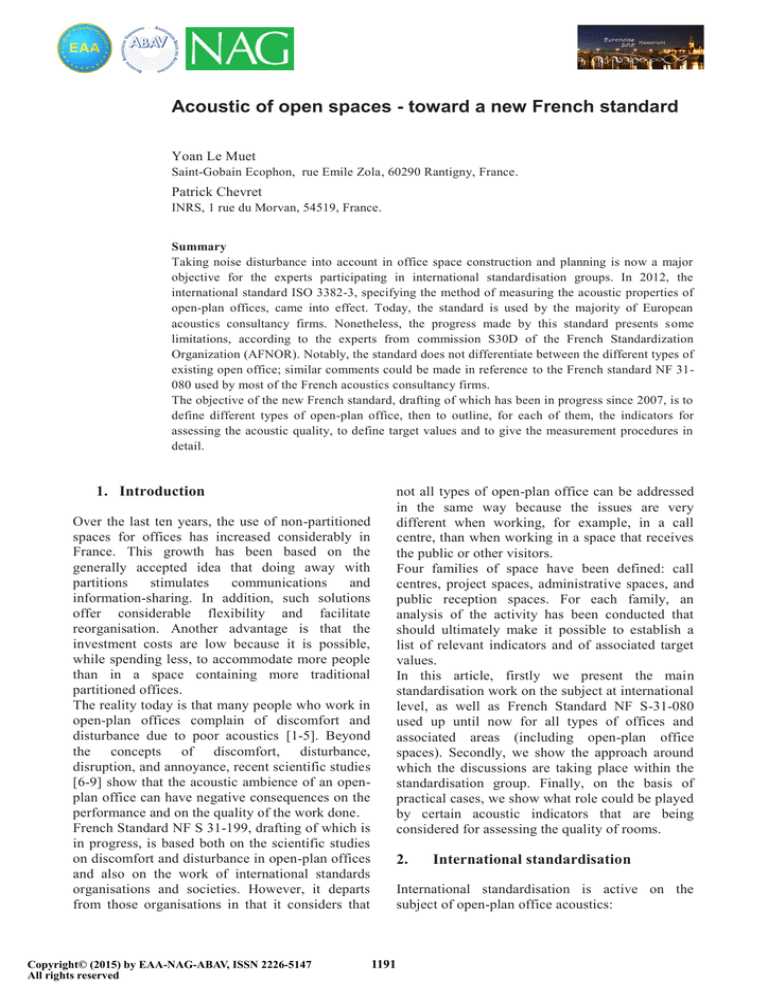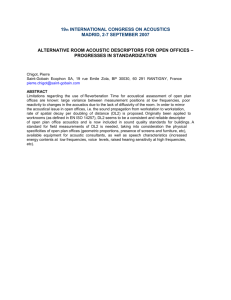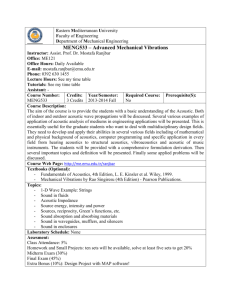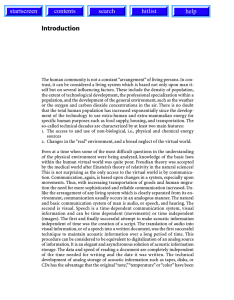
Acoustic of open spaces - toward a new French standard
Yoan Le Muet
Saint-Gobain Ecophon, rue Emile Zola, 60290 Rantigny, France.
Patrick Chevret
INRS, 1 rue du Morvan, 54519, France.
Summary
Taking noise disturbance into account in office space construction and planning is now a major
objective for the experts participating in international standardisation groups. In 2012, the
international standard ISO 3382-3, specifying the method of measuring the acoustic properties of
open-plan offices, came into effect. Today, the standard is used by the majority of European
acoustics consultancy firms. Nonetheless, the progress made by this standard presents some
limitations, according to the experts from commission S30D of the French Standardization
Organization (AFNOR). Notably, the standard does not differentiate between the different types of
existing open office; similar comments could be made in reference to the French standard NF 31080 used by most of the French acoustics consultancy firms.
The objective of the new French standard, drafting of which has been in progress since 2007, is to
define different types of open-plan office, then to outline, for each of them, the indicators for
assessing the acoustic quality, to define target values and to give the measurement procedures in
detail.
1. Introduction
not all types of open-plan office can be addressed
in the same way because the issues are very
different when working, for example, in a call
centre, than when working in a space that receives
the public or other visitors.
Four families of space have been defined: call
centres, project spaces, administrative spaces, and
public reception spaces. For each family, an
analysis of the activity has been conducted that
should ultimately make it possible to establish a
list of relevant indicators and of associated target
values.
In this article, firstly we present the main
standardisation work on the subject at international
level, as well as French Standard NF S-31-080
used up until now for all types of offices and
associated areas (including open-plan office
spaces). Secondly, we show the approach around
which the discussions are taking place within the
standardisation group. Finally, on the basis of
practical cases, we show what role could be played
by certain acoustic indicators that are being
considered for assessing the quality of rooms.
Over the last ten years, the use of non-partitioned
spaces for offices has increased considerably in
France. This growth has been based on the
generally accepted idea that doing away with
partitions
stimulates
communications
and
information-sharing. In addition, such solutions
offer considerable flexibility and facilitate
reorganisation. Another advantage is that the
investment costs are low because it is possible,
while spending less, to accommodate more people
than in a space containing more traditional
partitioned offices.
The reality today is that many people who work in
open-plan offices complain of discomfort and
disturbance due to poor acoustics [1-5]. Beyond
the concepts of discomfort, disturbance,
disruption, and annoyance, recent scientific studies
[6-9] show that the acoustic ambience of an openplan office can have negative consequences on the
performance and on the quality of the work done.
French Standard NF S 31-199, drafting of which is
in progress, is based both on the scientific studies
on discomfort and disturbance in open-plan offices
and also on the work of international standards
organisations and societies. However, it departs
from those organisations in that it considers that
Copyright© (2015) by EAA-NAG-ABAV, ISSN 2226-5147
All rights reserved
2.
International standardisation
International standardisation is active on the
subject of open-plan office acoustics:
1191
Y. Le Muet et al.: Acoustic of...
EuroNoise 2015
31 May - 3 June, Maastricht
3.
- Standard RIL 243-3-2008 [10] drafted by the
Finnish Association of Civil Engineers (RIL) is
based on the use of acoustic descriptors such as the
rate of spatial decay of sound pressure levels per
distance doubling ଶ [11] and the radius of
distraction ୈ which represents the distance from a
source of sound beyond which a listener is in a
comfort zone ( ൏ ͲǤͷ, the ܵܶܫ or “Speech
Transmission Index” being a Speech Transmission
index [12]). The standard recommends minimum
values for these two indexes. Computer simulation
software enabling forecast values to be compared
directly with recommended values is available on
the website of the Finnish Institute of Occupational
Health (FIOH) [13].
- The Standard Guide for Open Office Acoustics
[14] published by the ASTM (American Society
for Testing and Materials) indicates that “…, a
degree of acoustical privacy can be achieved if
component selection and interaction are
understood”. It also notes that obvious risks of
noise intrusion should be avoided; it gives
information about the directivity of a speaker. It
also indicates that the distractions caused by raised
voices or by loud office equipment cannot be kept
under control by normal open office construction
methods, and that use of partitioned spaces is then
recommended. Noise from telephone sets is
addressed. Use of acoustic absorbents on the
ceiling, on screens and on portions of the walls is
recommended. Finally, the advantage of an
electronic masking system is highlighted [15].
- Standard ISO 3382-3 [16] specifies methods of
measuring the acoustic properties of furnished
open-plan office spaces. That standard describes
the measurement methods, the necessary
instruments, the method of evaluating the
measurement data, and the presentation of the
acoustic test report. It also specifies the relevant
indictors, while emphasising the use of ଶௌ which
represents the decay of the sound pressure level
per distance doubling, for a normalised speech
spectrum.
That standard offers the advantage of being
focused exclusively on open offices. However, its
main drawback is that it makes no distinction on
the basis of activity of the office. And yet, clearly,
the expectations of people working in an open-plan
office are not the same if the work is of a
collaborative nature or requires extreme
concentration.
French Standard NF S 31-080 for
offices and related areas [17]
Up until the establishment of the acoustic standard
for offices, NF S 31-080 (2006), France had no
specific normative text relating to the comfort and
to the acoustic environment of workspaces. That
standard now establishes a link between
measurements of the acoustic quality of a room
and the levels of acoustic performance to be
attained by means of features of the construction
of the building. The performance levels are
expressed by standardised and traditional acoustic
criteria that are applicable to the building. It was
written in such a manner as to help with drafting of
specifications, and with design, execution, and
acceptance of work. It is applicable to new spaces,
to refurbishments, and to changes of use.
For all types of office, the standard defines the
sound environment class according to three levels
of performance (“Basic”, “Effective”, “Highly
effective”).
Standard NF S 31-080 is applicable not only for
individual offices, but also for collective offices,
open-plan offices, platforms to be fitted out/laid
out, meetings rooms, training rooms, relaxation
areas, and restaurants and canteens. It thus
encompasses room typologies that are very
different from one another. The main criteria
recommended by Standard NF S 31-080 are the
reverberation time ୰ of the room, and the linear
decayଶ . For several years numerous acoustic
measurements used reverberation time as the main
indicator of performance for buildings. Such
measuring is easy to perform. However, the values
obtained in the office are not always representative
of the acoustic quality. An inventory of a few
acoustic indicators that can be used in the context
of acoustics of non-partitioned offices, and some
examples of acoustic treatment for such spaces are
given in [18].
In view of the number of different activities that
can take place in an open-plan office, the AFNOR
S30D Commission decided to work on a new
approach in order to gain a better grasp of the
problem, and so as to correlate better with
subjective experience.
The new standard is an opportunity to take the
discussion deeper by addressing everything that
goes to make up an open-plan office, including the
additional items such as furniture, blinds, screens,
etc.
1192
EuroNoise 2015
31 May - 3 June, Maastricht
4.
Y. Le Muet et al.: Acoustic of...
The new standard NF S 31-199 – Open
offices: programming, design, and use
[19]
tired and fatigued at the end of the day and over
the longer term. The fitting-out of the call centre
should thus be appropriate for satisfying these
specific constraints. To that end, particular care
should be taken with the ceiling and the desk
dividers screen that separate the face-to-face
workstations. They should behave as acoustic
barriers while, at the same time, not offering too
much resistance to natural light (Figure 1). Desk
dividers also offer the possibility of increasing the
absorption surface area of the room.
The ambition of this standard is to lay down
principles, descriptors, and measurement methods
that correlate well with subjective perception of
sound. This new standard should also constitute a
basis for thought and dialogue between the various
players involved in creating and laying out/fitting
out open-plan offices in France. In particular, it
should enable project managers to hone their
specifications, while also assisting them in their
choices of acoustic objectives and resources as
regards architecture and fitting out. Open-plan
offices now have to adapt to accommodate all
types of activity, which often have very different
characteristics. Depending on the type of activity,
the acoustic issues can differ widely, with, for
example, need for intelligibility at certain locations
of the open-plan space or for certain activities, or,
conversely, need for discretion at the workstation
or between the teams.
Standard NF S 31-199 thus defines four types of
open-plan office space that are intended to
encompass the vast majority of existing activities:
call centres, project spaces, administrative spaces,
and public reception areas. For each type, the
issues are different because the activities are
different.
Figure 1. Attenuation of the speech spectrum (ISO33823) as a function of the height of the desk divider and for
different types of ceiling (INRS measurements)
Other items of the room, such as the floor and the
walls should be analysed, and parameters such as
how the work is organised and how the people are
distributed should be taken into account.
Indicators and target values will enable the expert
acousticians who use this new standard to provide
analyses and recommendations. Among such
indicators and target levels, we might mention the
level of background noise (equipment, footsteps,
etc.), the ambient noise when people are present,
and the spatial decay. The target values that are to
be defined in the standard will be based both on
simulations (see examples on Figure 2, [22]) and
on in-situ measurements such as presented on
Figure 3 [23].
4.1. Call centers
Call centers are open workspaces in which various
activities (sales activities, technical assistance,
etc.) take place essentially over the telephone. This
type of workspace is generally characterized by
large size, numerous sound sources and high
density of distribution of people often exceeding
the INRS recommendations of one workplace per,
at least, 10 m2 [20-21].
People are generally grouped together into small
groups of 4 to 10 people by means of “suitable”
furniture (bench desks or cluster desks). These
people, who are facing one another, communicate
frequently between two telephone calls or during
break periods. The presence of supervisors or even
“hypervisors” making it possible to manage and to
monitor information flows adds conversations to
the already existing babble.
The acoustic environment of the room should be
conducive to doing intellectual work that requires
a certain amount of concentration. It should also be
comfortable for people so that they are not too
1193
Y. Le Muet et al.: Acoustic of...
EuroNoise 2015
31 May - 3 June, Maastricht
advertising agencies, marketing and sales agencies,
consultancy firms, design offices, research centres,
etc. Communications within the space are above
all verbal. The number of simultaneous sound
sources can be quite large and the sound ambience
can be quite variable: a lively atmosphere with a
lot of interactions. Good intelligibility is necessary
between the people in the same team. Good
intelligibility over the telephone is also necessary.
However, there is also a need for discretion so as
to keep things from people who, while working in
the space, are not working on the project. An
indicator that is, in principle, preferred for
objectifying these concepts of intelligibility,
discretion, or indeed confidentiality/privacy is the
ܵܶܫ . On the basis of on-site measurements, it is
possible to determine the intelligibility zones
within an open-plan office, and thus to make
layout decisions depending on the needs of the
various departments or sections and on the
expectations of the employees. As an example,
Figure 4 shows a platform with a floor area of
several hundred square meters. Measurements of
ܵܶܫ were conducted in a portion of the room that
included mini meeting rooms adjoining one
another (points referenced 1 to 4 in Figure 4). In
Figure 5, it can be observed that the intelligibility
was always greater than or equal to 60%, that
value clearly indicating lack of confidentiality for
the conversations in one booth relative to a
neighbouring booth, or even relative to a booth
that was further away.
Figure 2. Simulation of decay curves in an open-plan
office (performed with RAYPLUS software [22])
Figure 3. Distribution of the ambient noise levels
measured in call centers [23].
Figure 4. Example of a collaborative workspace: overall
plan and measurement points for measuring ܵܶ ݎܫin an
open-plan office (the floor area of this platform is 850
m2 )
4.2. Project spaces
This type of space is used for collaborative work.
It is occupied by groups of people and teams
working on the same project and who need to do
individual tasks requiring limited concentration.
This type of space is used, for example, by
1194
EuroNoise 2015
31 May - 3 June, Maastricht
Y. Le Muet et al.: Acoustic of...
conventional room acoustics indicators is not
sufficient to characterize an open-plan.
Implementing absorbent ceilings and screens made
it possible to increase the spatial decay (4.8 dB(A)
before and 8.4 dB(A) after) and to improve what
the people felt, as shown in Table 1.
How would you rate the acoustic environment of
the room?
Before After
Number of answers (%)
15
10
Very good (%)
0
0
Good (%)
20
60
Neither good nor bad (%)
20
30
Poor (%)
40
10
Very poor (%)
20
0
Figure 5: Intelligibility for the various measurement
positions identified in Figure 4
The ܵܶܫ makes it possible to finely analyse the
intelligibility in a room. However, deployment of
measurement on a site can be complex, and
acquiring the equipment can represent a cost that
many design offices would not be able to bear.
This an essential point to be taken into account by
the
standardisation
commission
when
implementing the new standard.
Table 1: Results of the subjective questionnaire,
expressed as percentages. The subject had to rate the
sound environment before and after the works.
4.4. Public reception spaces
This type of space can correspond to reception
areas of public bodies, insurance companies,
banks, etc. It is organised to be conducive to
holding meetings, and it should enable large
numbers of interactions to take place between the
staff and customers. The space is designed to
receive the public and to facilitate individual work.
The public can be received in spaces of the
“counter” or “window” type or they can be seated
in partitioned offices if the interview requires a
longer time or a certain amount of privacy.
Between two interviews or appointments, the staff
may have to input data or write reports, which
requires relatively high concentration. In most
cases, the activity of the employees is noncollaborative, and the exchanges take place faceto-face with the customer. The exchanges are often
of a private nature, and it is therefore necessary to
have a certain amount of discretion or indeed
confidentiality. The sound sources, which consist
essentially of verbal exchanges between people,
are manifold and simultaneous. The voice levels in
this type of space can vary to a large extent
depending on the type of activity and on the period
in question (e.g. during peak times).
The level of ambient noise is relatively high.
Emergences are regular and sometimes very
pronounced. The degree of disturbance due to such
emergences is high.
4.3. Administrative spaces
This type of space is essentially intended for
individual work. It is designed to host activities of
the following types: business administration,
accounting, human resources, purchasing, etc. The
activity within a team in such a space is
undifferentiated and non-collaborative. It requires
high concentration from the employees, who are
typically grouped together in teams of from 1 to 8
people, who can occasionally communicate
(between colleagues, or over the telephone). The
ambient noise level is therefore low over quite
long periods (from several tens of seconds to
several minutes), which sometimes gives rise to
high emergences that can disturb the ambience of
the open-plan office. There is therefore a need not
only for intelligibility at the workstation, but also
for discretion relative to the other workstations, in
particular when several departments or sections are
brought together within the same open-plan space.
This type of space was specifically investigated in
the course of the Nice Report [24]. Those
measurements were taken in five open-plan office
spaces, and were accompanied by a survey
gathering the subjective judgments of the staff.
That investigation showed that the use of
1195
Y. Le Muet et al.: Acoustic of...
5.
EuroNoise 2015
31 May - 3 June, Maastricht
Conclusions
ratio, and binaural unmasking” Journal of Experimental
Psychology: Human Perception and Performance,
24(5): p. 1406-1414 (1998).
[10] RIL 243-3-2008, “Rakennusten akustinen
suunnittelu: toimistot (acoustic design of building
offices)”, Helsinki (2008).
[11] ISO 14247-2001, “Acoustics – Measurement of the
spatial sound level decay curve”, Geneva (2001).
[12] NF EN 60268-16 – “Sound system equipment Part 16: Objective rating of speech intelligibility by
speech transmission index” (2003).
[13] FIOH, “Room acoustic modeling of an open plan
office”, http://www.ttl.fi/openofficeacoustics, FIOH,
Helsinki (2007).
[14] ASTM E 1374-02, “Standard guide for open office
acoustics”, (2002)
[15] ASTM E 1573-09, “Standard test method for
evaluating masking sound in open offices using A
weighted and one third octave band sound pressure
levels” (2009)
[16] ISO 3382-3, “Acoustics - Measurement of room
acoustic parameters - Part 3: Open plan offices”,
Geneva (2012)
[17] NF S31-080 “Acoustics – Offices and associated
spaces – Levels and criteria of acoustic performances
per type of space” (in French), French Standard
Organization AFNOR (2006)
[18] E. Nilsson, B. Hellström, “Room acoustic design
in open-plan offices”, Proceedings of Euronoise 2009,
Edinburgh (2009)
[19] Pr NF S 31-199, “Acoustics – Open plan offices –
Programming, conception and use” (project, in French),
AFNOR, (to be published in 2015)
[20] ED 108, “The Call Centers” (in French), INRS
(2003)
[21] NF X35-102, “Ergonomic Conception of Work
offices” (in French), AFNOR (1998)
[22] P. Chevret, J. Chatillon, “Implementation of
diffraction in a ray-tracing model for the prediction of
noise in open-plan offices” J. Acoust. Soc. Am. 132(5),
3125-3137 (2012)
[23] N. Trompette, J. Chatillon, “Auditory risk
evaluation for operators in call centers and solutions of
prevention” (in French), NS 289, INRS, 49 p. (2010)
[24] N. Hellstöm, “Acoustic design of open-plan
offices” NT technical report 619.
http://nordtest.info/index.php/download/category/acoust
ic.html (2010)
[25] M. Pierrette, E. Parizet, P. Chevret & J. Chatillon
Noise effect on comfort in open-space offices:
Development of an assessment questionnaire,
Ergonomics, 58:1, 96-106,
DOI: 10.1080/00140139.2014.961972 (2015)
After a few years of experience in using French
Standard NF S31-080 that highlighted the diversity
of situations encountered in spaces of the open
office type, the standardization committee AFNOR
S30D is proposing, in a new standard that is being
prepared, a classification of open offices and a
differentiated analysis approach. As a result,
indicators and target values are being proposed
that can differ depending on the zone in question:
workstation, team, or department.
In order to cope with potential conflict situations,
such as measuring noise at the workstations of
office spaces, an appendix to the draft will also
propose
a
measurement
methodology,
accompanied by parameters that describe the
working situation and that should be recorded.
Finally,
in
order
to
enable
the
disturbance/discomfort felt by people to be
assessed, a questionnaire based on a recent survey
[25] will also be proposed by way of information.
References
[1] G.W. Evans, D. Johnson, “Stress and open office
noise”, Journal of Applied Psychology, 85(5), 779-783
(2000)
[2] N-Å Andersson, P. Chigot, “Is the Privacy Index a
good indicator for acoustic comfort in an open plan
area”. Inter-noise 2004, Prague (2004)
[3] S. Banbury, D. C. Berry, “The disruption of officerelated tasks by speech and office noise” British journal
of psychology, 89, 499-517 (1998).
[4] D. E. Broadbent, “The current state of noise
research: Reply to Poulton”, Psychological Bulletin, 85,
1052-1067 (1978).
[5] D. M. Jones, W. J. Macken, “Auditory babble and
cognitive efficiency: role of number of voices and their
location”, Journal of experimental psychology: applied,
1, 216-226 (1995).
[6] N. D. Weinstein, “Effect of noise on intellectual
performance”, Journal of Applied Psychology, 59(5),
548-554 (1974).
[7] S. J. Schlittmeier, J. Hellbrück, R. Thaden, and M.
Vörlander, “The impact of background speech on
intelligibility: Effect on cognitive performance and
perceived disturbance.” Ergonomics, 51(5): p. 719-736
(2008).
[8] H. A. Colle, A. Welsh, “Acoustic masking in
primary memory.” Journal of Verbal Learning and
Verbal Behavior, 15(1): p. 17-31 (1976).
[9] W. Ellermeier, J. Hellbrück, “Is level irrelevant in
"irrelevant speech"? Effects of loudness, signal-to-noise
1196







